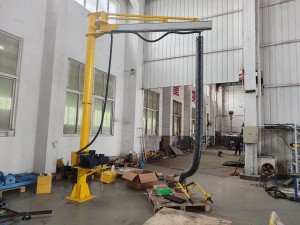A vacuum lifter is a material handling device that uses vacuum suction to safely and efficiently grip, lift, and move objects. It works by creating a vacuum between its suction pads and the surface of a load, which generates a powerful suction force that allows a single operator to lift heavy items with minimal physical effort.
How They Work?
The core principle of a vacuum lifter is a simple concept of pressure difference. A typical system consists of:
- A vacuum pump that draws air out of the system.
- A lifting tube or arm connected to the vacuum pump.
- One or more suction pads at the end of the tube that make contact with the object.
When the suction pads are placed on a non-porous, relatively smooth surface, the vacuum pump creates a low-pressure zone between the pad and the object. The higher atmospheric pressure outside then pushes the object firmly against the suction pad, creating a secure grip. To lift the object, the operator increases the vacuum level, causing the lifting tube to contract. To lower the object, air is gradually released back into the system, and to release the object completely, the vacuum is eliminated.
Types and Applications
There are two primary types of vacuum lifters, each suited for different tasks:
- Vacuum Tube Lifters: These use a large, flexible tube that acts as both the vacuum hose and the lifting mechanism. They are designed for high-frequency, repetitive lifting of items like boxes, sacks, barrels, or smaller rolls, typically up to 300 kg.
- Vacuum Grippers: These are larger, more robust systems that use a rigid frame with an array of suction pads. They are ideal for handling heavy, flat, and stable loads such as large glass panels, metal sheets, stone slabs, or wooden boards, often with lifting capacities of several tons.
Advantages
Vacuum lifters provide a wide range of benefits for industrial and construction environments:
- Safety and Ergonomics: They virtually eliminate the physical strain of heavy lifting, which drastically reduces the risk of musculoskeletal injuries (MSIs) for workers.
- Increased Productivity: A single operator can perform tasks that would otherwise require multiple people, and the speed of the lifter reduces cycle times and operational downtime.
- Damage Prevention: The soft suction pads grip the load firmly without using hooks, chains, or clamps, which could scratch, dent, or deform the material.
- Versatility: The system’s suction pads can be easily swapped out to accommodate a wide variety of load sizes, shapes, and materials.
- Precision: Vacuum lifters allow for precise control and positioning of objects, which is crucial for tasks like placing glass into a window frame or loading parts onto a machine.
Thanks for reading! I’m Loren, responsible for the global automation equipment export business at Tongli Industrial.
We provide high-precision loading and unloading manipulator robots to help factories upgrade to intelligence.
If you need product catalog or customized solution, please contact:
Email: manipulator@tongli17.com | Mobile Phone: +86 159 5011 0267
Post time: Aug-18-2025



